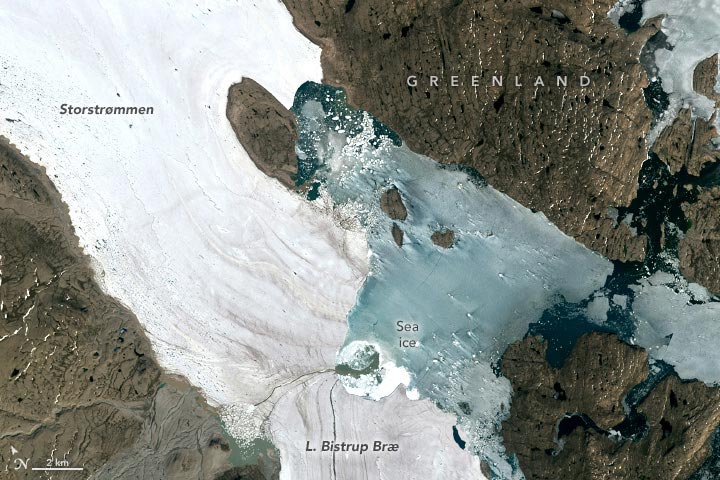
Satellite image of the Storstrømmen and L. Bistrup Bræ glaciers acquired on July 21, 2023, by the Operational Land Imager-2 (OLI-2) on Landsat 9.
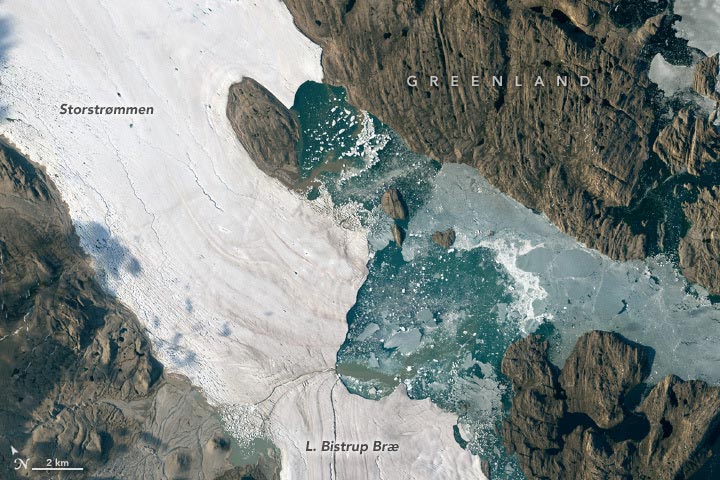
Satellite image of the Storstrømmen and L. Bistrup Bræ glaciers acquired on July 25, 2023, by the Operational Land Imager (OLI) on Landsat 8.
Seasonal warmth led to the rapid disintegration of sea ice near the junction of two large outlet glaciers.
Summer can be harsh on the planet’s remaining ice. In just a few days during July 2023, the seasonal warmth led to the rapid disintegration of sea ice near the junction of two large outlet glaciers in northeast Greenland.
The two glaciers—Storstrømmen and L. Bistrup Bræ—are visible in this pair of images. Storstrømmen, the larger of the two, measures around 20 kilometers (12 miles) wide and flows southward. It joins with L. Bistrup Bræ, and together their ice extends into fjord waters, forming the southernmost floating ice tongue in East Greenland.
Ice Disintegration: Images and Causes
The first satellite image (upper) shows the region on July 21, 2023. A pocket of persistent open water, or polynya, had formed within the fjord’s sea ice near the front of the glaciers. By July 25 (lower), the sea ice had broken out. Images were acquired by the Operational Land Imager-2 (OLI-2) on Landsat 9 and the OLI on Landsat 8, respectively.
“The likely cause of the rapid disintegration is probably a wind-driven effect when the sea ice was already warm and weak,” said Christopher Shuman, a University of Maryland, Baltimore County, glaciologist based at NASA’s Goddard Space Flight Center. “Think of it like a wet paper towel being pulled apart as the winds blew across the area.”
Impact of Warmth
Some of the warmth likely came from Randsøen Lake at the edge of the glacier junction, visible toward the left side of the image above. This persistent lake collects summer meltwater from the margins of both glaciers. Streams atop the glaciers then carry the dark, sediment-laden water into the fjord, where the water continues to absorb more heat. The polynya grew larger until the sea ice broke out on July 23.
Glaciers’ Unique Environment
Aside from seasonally warm areas, the ocean water near Storstrømmen and L. Bistrup Bræ is quite cold. In fact, research has shown that the shallow shape of the seafloor prevents warm Atlantic water from accessing these glaciers and melting them from below—a common phenomenon elsewhere around Greenland.
Historical Changes
Nevertheless, retreat has been noted at the glacier’s grounding zones—the region where glacial ice resting on the bedrock begins to float—since the mid-1990s. And the overall recent retreat of the glacier fronts is likely related to thinning of the glaciers via long-term processes such as surface melting, and their adjustment to the rapid advance of Storstrømmen between 1978 and 1984.
NASA Earth Observatory images by Wanmei Liang, using Landsat data from the U.S. Geological Survey.

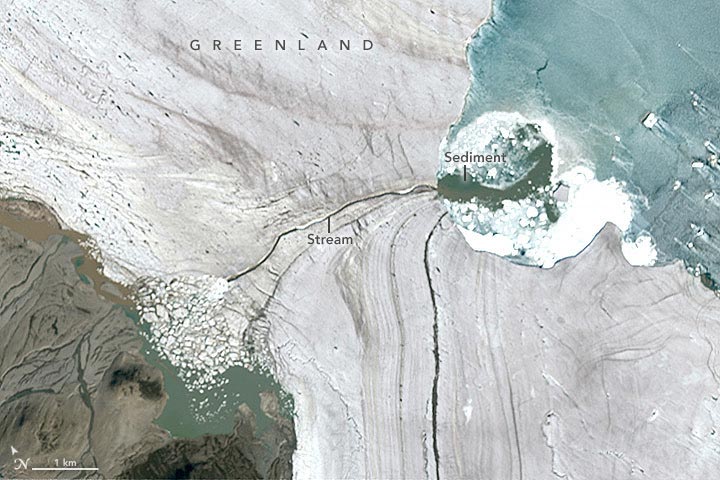



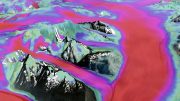


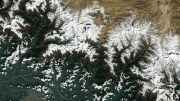
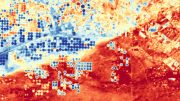
Be the first to comment on "Summer Breakout: Rapid Disintegration of Sea Ice in Northeast Greenland"